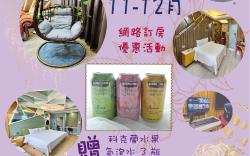GFun Functional Life Center Introduction
When you arrive at the GFun Functional Living Museum, you will see a vibrant little forest area paved with recycled wooden pallets, featuring a pebble health path and wooden tables and chairs for relaxation, adding a touch of warmth to the factory environment. Entering the living museum, you can get a preliminary understanding of the development of fiber production from the lively and informative displays on the walls. During the visit to the sightseeing factory, you sequentially see the process of fabric processing in the production area, including fabric inspection upon arrival, fabric joining, calendering, coating and bonding, curing, water repellency processing, printing and mesh application, physical property assessment, and fabric inspection and packaging. It turns out that fabric production must go through so many stages. Next, through glass, you can see the quality assurance test area, where tests for water repellency, water pressure resistance, pH value, moisture permeability, breathability, peel strength, tear strength, prevention of seam water seepage, and various washing tests of different strengths are conducted. After so many tests, the quality can be assured, producing excellent functional fabrics. With specialized quality control, tourists are most interested in trying on GFun's waterproof and breathable raincoat, personally walking through a wind and rain experience corridor to feel the impact of various intensities of rain, witnessing the complete protection of waterproof and breathable products without discomfort and ensuring comfort. Commonly seen in the market are functional clothing like cool feeling shirts, heating shirts, or moisture-wicking, quick-drying, windproof, breathable, warm, water-repellent, UV-resistant, and antibacterial attires. These garments have elevated the comfort needs of wearing to also care for the body, placing greater emphasis on the acquisition of raw materials and reducing environmental pollution during the manufacturing process. Thus, at GFun, you can learn how to make a piece of clothing using 3 cups of coffee and 5 recycled PET bottles. Understanding these extraction techniques and the commitment to protecting the environment can inspire visitors during the tour and help them learn how to conserve energy and reduce carbon emissions in their clothing choices.









































